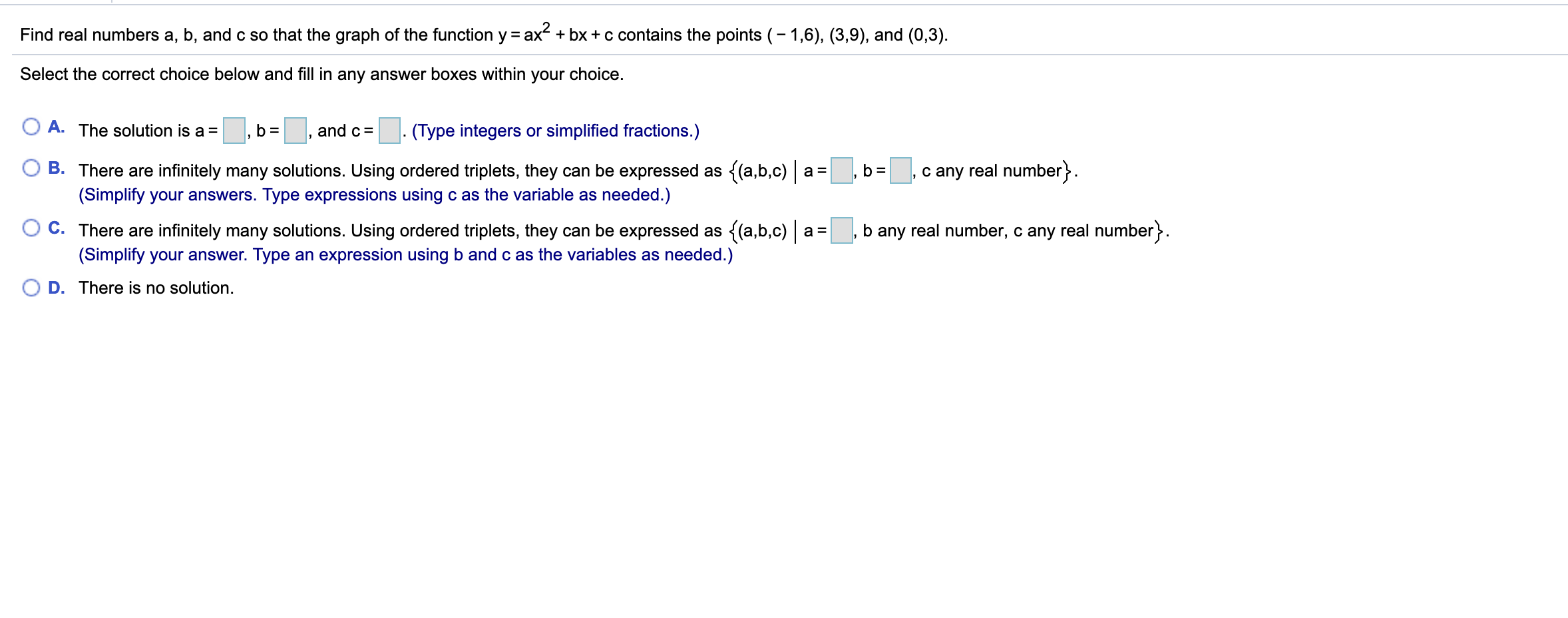Find real numbers a, b, and c so that the graph of the function y = ax + bx+c contains the points (- 1,6), (3,9), and (0,3). Select the correct choice below and fill in any answer boxes within your choice. A. The solution is a = , and c= (Type integers or simplified fractions.) B. There are infinitely many solutions. Using ordered triplets, they can be expressed as {(a,b,c) a (Simplify your answers. Type expressions using c as the variable as needed.) c any real number}. C. There are infinitely many solutions. Using ordered triplets, they can be expressed as {(a,b,c) a= b any real number, c any real number}. (Simplify your answer. Type an expression using b and c as the variables as needed.) D. There is no solution.
Find real numbers a, b, and c so that the graph of the function y = ax + bx+c contains the points (- 1,6), (3,9), and (0,3). Select the correct choice below and fill in any answer boxes within your choice. A. The solution is a = , and c= (Type integers or simplified fractions.) B. There are infinitely many solutions. Using ordered triplets, they can be expressed as {(a,b,c) a (Simplify your answers. Type expressions using c as the variable as needed.) c any real number}. C. There are infinitely many solutions. Using ordered triplets, they can be expressed as {(a,b,c) a= b any real number, c any real number}. (Simplify your answer. Type an expression using b and c as the variables as needed.) D. There is no solution.
Chapter5: Polynomial And Rational Functions
Section5.5: Zeros Of Polynomial Functions
Problem 51SE: Use Descartes’ Rule to determine the possible number of positive and negative solutions. Then graph...
Related questions
Question

Transcribed Image Text:Find real numbers a, b, and c so that the graph of the function y = ax + bx+c contains the points (- 1,6), (3,9), and (0,3).
Select the correct choice below and fill in any answer boxes within your choice.
A. The solution is a =
, and c=
(Type integers or simplified fractions.)
B. There are infinitely many solutions. Using ordered triplets, they can be expressed as {(a,b,c) a
(Simplify your answers. Type expressions using c as the variable as needed.)
c any real number}.
C. There are infinitely many solutions. Using ordered triplets, they can be expressed as {(a,b,c) a=
b any real number, c any real number}.
(Simplify your answer. Type an expression using b and c as the variables as needed.)
D. There is no solution.
Expert Solution
This question has been solved!
Explore an expertly crafted, step-by-step solution for a thorough understanding of key concepts.
This is a popular solution!
Trending now
This is a popular solution!
Step by step
Solved in 3 steps with 3 images

Recommended textbooks for you


Algebra & Trigonometry with Analytic Geometry
Algebra
ISBN:
9781133382119
Author:
Swokowski
Publisher:
Cengage

College Algebra (MindTap Course List)
Algebra
ISBN:
9781305652231
Author:
R. David Gustafson, Jeff Hughes
Publisher:
Cengage Learning


Algebra & Trigonometry with Analytic Geometry
Algebra
ISBN:
9781133382119
Author:
Swokowski
Publisher:
Cengage

College Algebra (MindTap Course List)
Algebra
ISBN:
9781305652231
Author:
R. David Gustafson, Jeff Hughes
Publisher:
Cengage Learning

Algebra: Structure And Method, Book 1
Algebra
ISBN:
9780395977224
Author:
Richard G. Brown, Mary P. Dolciani, Robert H. Sorgenfrey, William L. Cole
Publisher:
McDougal Littell

Elementary Algebra
Algebra
ISBN:
9780998625713
Author:
Lynn Marecek, MaryAnne Anthony-Smith
Publisher:
OpenStax - Rice University

Big Ideas Math A Bridge To Success Algebra 1: Stu…
Algebra
ISBN:
9781680331141
Author:
HOUGHTON MIFFLIN HARCOURT
Publisher:
Houghton Mifflin Harcourt